Experimental Evaluation of the Effect of Replacing Diesel Fuel by CNG on the Emission of Harmful Exhaust Gas Components and Emission Changes in a Dual-Fuel Engine
Abstract
:1. Introduction
Purpose of the Study and Literature Review
2. Materials and Methods
Methodology for Determining the Effect of the CNG/ON Substitution Factor on Engine Emission
- For two values of load torque in a constant engine speed of 1100 rpm for approx. 520 Nm (61 kW), which was shown on charts as a curve “A”, and 1150 Nm (139 kW), which was shown on charts as a curve “B”;
- For two values of load torque in a constant engine speed of 1300 rpm for approx. 480 Nm (67 kW), which was shown on charts as a curve “C”, and 980 Nm (134 kW), which was showed on charts as a curve “D”;
- For two values of load torque in a constant engine speed of 1500 rpm, approx. 500 Nm (79 kW), which was shown on charts as a curve “E”, and 1040 Nm (163 kW), which was shown on charts as a curve “F”.
- -
- Two injectors working in parallel-supplying one cylinder, mounted in a transition plate fitted between the head and the intake manifold;
- -
- The operating pressure of the system: CNG-8 bar;
- -
- Gas injection rail supply double-sided to avoid pressure drops;
- -
- An achieved energy conversion rate of up to 95% for diesel/CNG, which is significantly better than installations generally available on the market;
- -
- The installation is dedicated to a specific engine family/brand, when changing engines, it is re-optimized on a dynamometer bench;
- -
- A bypass valve used in the intake system to regulate boost pressure when running on CNG to avoid knocking combustion.
- -
- Automatic changeover to dual-fuel operation when conditions are met—minimum reducer temperature, minimum engine crankshaft speed, and others;
- -
- Adaptation of the switching time from mono- to bi-fuel operation between cylinders to maintain engine stability;
- -
- Method of implementation of diesel to CNG changeover—fixed value or after map shaft rpm/diesel dose;
- -
- Minimum diesel pilot dose;
- -
- Factor which changes the gas dosage relative to the calculated diesel dosage x;
- -
- Reduction in the diesel dose in proportion to the preset replacement of diesel by CNG;
- -
- Possibility to program any coefficient of substitution of diesel by CNG over the whole field of work-speed-dose of basic fuel diesel;
- -
- Possibility of programming any gas injection start angle in relation to GMP in the whole working field-rotational-speed dose of the basic fuel, i.e., diesel;
- -
- Correction of gas dose in relation to the pressure in the engine intake system and the engine crankshaft speed—the function is necessary for the engine power correction-after switching to diesel/CNG supply;
- -
- Possibility of programming correction of the gas dosage in relation to the pressure in the engine intake system and to the engine crankshaft speed—a function necessary for correcting the engine power after switching to diesel/CNG supply;
- -
- Throttle control using bypass over the entire operating field-speed-base fuel dose diesel—after map or fixed value. This function is designed to reduce the pressure in the intake system by bleeding some of the air into the intake pipe before the charge air coolers.
- -
- No occurrence of detonation combustion during CNG fueling;
- -
- Maximum diesel substitution by CNG;
- -
- Obtaining the same useful power at a given accelerator pedal position and speed;
- -
- Limitation of the increase in exhaust gas temperature at the turbocharger outlet;
- -
- Function-> Gas inj. end moment, end of injection angle—depending on engine speed—maximum engine power, and no knocking combustion were taken as criteria for the optimal value of the end of injection angle;
- -
- Diesel/CNG exchange/replacement ratio depending on engine speed with engine load identified as diesel output dose—the maximum value of the aforementioned ratio without the occurrence of knocking combustion was adopted as the criterion for the optimal diesel/CNG exchange/replacement ratio depending on engine speed and dose;
- -
- Correction of the gas dosage in relation to boost pressure—the function allows the generated power to be corrected after switching over to diesel/CNG. The correction allows the gas dosage to be increased or decreased to obtain the same effective power as diesel operation;
- -
- DSC function RPM/DIESEL DOSE bypass throttle opening map as a function of shaft speed and calculated ON dose as a criterion for optimum ON/CNG exchange/replacement ratio, were adopted as functions of crankshaft speed and liquid fuel dose. The maximum value of the abovementioned ratio was adopted without the occurrence of knocking combustion.
3. Results
Summary of the Results
- Summarizing all the above, the following analysis of the obtained results can be carried out: Studies that have been carried out indicate that emissions of certain harmful exhaust components must be reduced. Their emissions have increased too much, and the values must be corrected if the engine is to be used today.
- CO emissions at one run are much higher than the other runs.
- NOX emissions, including both NO and NO2 in some test runs, increase with the degree of diesel replacement with CNG, and decrease in others.
4. Discussion
5. Conclusions
- The tests carried out to make it possible to state unequivocally that the engine modification carried out did not make it possible to limit the emission of all harmful components of exhaust gases whose emission is limited by contemporary EU regulations.
- The emission of hydrocarbons has increased in such a way as to make it impossible to comply with contemporary exhaust emission standards. Their emission is related to the incomplete combustion of fuels supplied to the combustion chamber, and the largest increases relate to methane emissions, which is the main and basic component of CNG fuel.
- Emissions of nitrogen oxides did not change with the increase in the substitution of diesel for CNG in a way that significantly affects the engine’s ability to meet modern emission standards. This is evidenced by the similar rate and temperature of the combustion process for both mono- and bi-fuel fueling, and the change in the amount of CNG used does not significantly affect emissions.
- NOX emissions did not change significantly as the degree of diesel-to-CNG replacement increased. This indicates that there was no significant change in the combustion of fuels in the engine under study where the combustion temperature should have decreased, resulting in lower NOX emissions.
- The failure to adapt the combustion chamber to burn gaseous fuel in a fuel–air mixture close to stoichiometric results in increased hydrocarbon emissions. Emissions of all hydrocarbon compounds in most test runs increased with the degree level of substitution of diesel by CNG, indicating an insufficient availability of oxidant in the combustion process, and therefore insufficient mixing of fuel and air, and the existence of areas in the combustion chamber that are too rich and potentially too poor.
- Simple conversion of an engine to so-called “gas-diesel” does not make it possible to reduce the emission of harmful components by the engine to a level that would allow the engine to meet the higher emission levels envisaged in the production of a bi-fuel converted engine.
- -
- Carry out tests in which additional flue gas components such as H2, H2O, SO2, N2O, N2O5, and other NOY- and NOZ-forming substances will be measured.
- -
- Check the emissions of the various components of the exhaust gas after being routed through the original catalytic reactor of the engine under test.
- -
- Repeat the tests carried out, as the determination of emission values with a single measurement is an unreliable source of information and, when comparing changes in emission values, it is important to establish a trend based on a number of the same tests in order to identify differences and similarities indicating whether a result has been achieved.
- -
- Compare the results obtained when using a different generation of gas system on the same engine
- -
- Carry out a full modification of the engine, including the rebuilding of the combustion chamber and valve train in order to compare emission test results on the engine thus modified.
Author Contributions
Funding
Data Availability Statement
Conflicts of Interest
References
- Karczewski, M.; Szamrej, G.; Chojnowski, J. Experimental Assessment of the Impact of Replacing Diesel Fuel with CNG on the Concentration of Harmful Substances in Exhaust Gases in a Dual Fuel Diesel Engine. Energies 2022, 15, 4563. [Google Scholar] [CrossRef]
- Reitz, R.D.; Duraisamy, G.D. Review of high efficiency and clean reactivity controlled compression ignition (RCCI) combustion in internal combustion engines. Prog. Energy Combust. Sci. 2015, 46, 12–71. [Google Scholar] [CrossRef] [Green Version]
- Chojnowski, J.; Karczewski, M.; Szamrej, G. The phenomenon of knocking combustion and the impact on the fuel exchange and the output parameters of the diesel engine operating in the dual-fuel mode (Diesel-CNG). NAŠE MORE 2021, 17, 30. [Google Scholar]
- Karim, G.A. Dual-Fuel Diesel Engines; CRC Press: New York, NY, USA, 2015. [Google Scholar]
- Li, Y.; Jia, M.; Xu, L.; Bai, X.-S. Multiple-Objective Optimization of Methanol/Diesel Dual-Fuel Engine at Low Loads: A Comparison of Reactivity Controlled Compression Ignition (RCCI) and Direct Dual Fuel Stratification (DDFS) Strategies. Fuel 2020, 262, 116673. [Google Scholar] [CrossRef]
- Available online: https://www.ac.com.pl/products-autogas/controllers-lpg-cng-diesel/stag-diesel/338/ (accessed on 20 October 2022).
- Available online: https://www.europegas.pl/en/eg-injecto-duo/ (accessed on 21 October 2022).
- Available online: https://polandasia.com/cz%C5%82onkostwo/nasi-partnerzy/dual-fuel-systems/ (accessed on 21 October 2022).
- Available online: https://fuelfusion.pl/firma/ (accessed on 21 October 2022).
- Al-Saadi, A.A.A.; Bin Aris, I. CNG-diesel dual fuel engine: A review on emissions and alternative fuels. In Proceedings of the 2015 10th Asian Control Conference (ASCC), Kota Kinabalu, Malaysia, 31 May–3 June 2015; pp. 1–4. [Google Scholar] [CrossRef]
- Smallwood, J.S. Investigation of the Dual-Fuel Conversion of a Direct Injection Diesel Engine. Master’s Thesis, Department of Mechanical and Aerospace Engineering, Morgantown, WV, USA, 2013; p. 3410. [Google Scholar]
- Andrych-Zalewska, M.; Chlopek, Z.; Merkisz, J.; Pielecha, J. Comparison of Gasoline Engine Exhaust Emissions of a Passenger Car through the WLTC and RDE Type Approval Tests. Energies 2022, 15, 8157. [Google Scholar] [CrossRef]
- Stelmasiak, Z.; Larisch, J.; Pietras, D. Wpływ dodatku gazu ziemnego na wybrane parametry pracy silnika Fiat 1.3 MultiJet zasilanego dwupaliwowo. Combust. Engines 2015, 54, 672–682. [Google Scholar]
- Jamrozik, A.; Tutak, W.; Grab-Rogaliński, K. An Experimental Study on the Performance and Emission of the diesel/CNG Dual-Fuel Combustion Mode in a Stationary CI Engine. Energies 2019, 12, 3857. [Google Scholar] [CrossRef] [Green Version]
- Hanna, R.N.; Mustafa, A.M.; Zefaan, H.; Sameh, M.M. Aftermarket exhaust gas emissions analysis of a direct injection CNG-Diesel dual fuel engine. Int. J. Curr. Res. 2016, 8, 29321–29329. [Google Scholar]
- Singh, R.; Maji, S. Performance and exhaust gas emissions analysis of direct injection cng-diesel dual fuel engine. Int. J. Eng. Sci. Technol. 2012, 4, 833–846. [Google Scholar]
- Reitz, R.D.; Foster, D.; Ghandhi, J.; Rothamer, D.; Rutland, C.; Trujillo, M.; Sanders, S. Optimization of Advanced Diesel Engine Combustion Strategies. DOE Merit Review, ACE020. 2011. Available online: https://www.energy.gov/sites/prod/files/2014/03/f10/ace020_reitz_2012_o.pdf (accessed on 24 October 2022).
- Reitz, R. Fuel Reactivity Controlled Compression Ignition (RCCI)—A Practical Path to High-Efficiency, Ultra-Low Emission. Int. J. Engine Res. 2011, 12, 209–226. [Google Scholar]
- Dziubak, T. Experimental Studies of Dust Suction Irregularity from Multi-Cyclone Dust Collector of Two-Stage Air Filter. Energies 2021, 14, 3577. [Google Scholar] [CrossRef]
- Dziubak, T.; Bąkała, L. Computational and Experimental Analysis of Axial Flow Cyclone Used for Intake Air Filtration in Internal Combustion Engines. Energies 2021, 14, 2285. [Google Scholar] [CrossRef]
- Zheng, J.; Wang, J.; Zhao, Z.; Wang, D.; Huang, Z. Effect of equivalence ratio on combustion and emissions of a dual-fuel natural gas engine ignited with diesel. Appl. Therm. Eng. 2019, 146, 738–751. [Google Scholar] [CrossRef]
- Pham, V.C.; Choi, J.-H.; Rho, B.-S.; Kim, J.-S.; Park, K.; Park, S.-K.; Le, V.V.; Lee, W.-J. A Numerical Study on the Combustion Process and Emission Characteristics of a Natural Gas-Diesel Dual-Fuel Marine Engine at Full Load. Energies 2021, 14, 1342. [Google Scholar] [CrossRef]
- Benajes, J.; García, A.; Monsalve-Serrano, J.; Boronat, V. Dual-Fuel Combustion for Future Clean and Efficient Compression Ignition Engines. Appl. Sci. 2017, 7, 36. [Google Scholar] [CrossRef]
- Regulamin EKG ONZ nr 49 Europejskiej Komisji Gospodarczej Organizacji Narodów Zjednoczonych (EKG/ONZ). Available online: https://eur-lex.europa.eu/LexUriServ/LexUriServ.do?uri=OJ:L:2011:180:0053:0069:PL:PDF (accessed on 15 October 2022).
- Kuiken, K. Book I: Principles. In Gas- and Dual-Fuel Engines for Ship Propulsion, Power Plants, and Cogeneration; Target Global Energy Training: Onnen, The Netherlands, 2016; pp. 1–488. [Google Scholar]
- Karczewski, M.; Chojnowski, J.; Szamrej, G. A Review of Low-CO2 Emission Fuels for a Dual-Fuel RCCI Engine. Energies 2021, 14, 5067. [Google Scholar] [CrossRef]
- DieselNet Emission Standards: EU: Cars and Light Trucks. Available online: https://dieselnet.com/standards/eu/ld.php (accessed on 30 October 2022).
- DieselNet Emission Standards: EU: Heavy-Duty Truck and Bus Engines. Available online: https://dieselnet.com/standards/eu/hd.php (accessed on 30 October 2022).
- Preliminary Findings on Possible Euro 7 Emission Limits for LD and HD Vehicles. Available online: https://circabc.europa.eu/sd/a/fdd70a2d-b50a-4d0b-a92a-e64d41d0e947/CLOVE%20test%20limits%20AGVES%202020-10-27%20final%20vs2.pdf (accessed on 30 October 2021).
- DieselNet Emission Standards: EU World Harmonized Transient Cycle (WHTC). Available online: https://dieselnet.com/standards/cycles/whtc.php (accessed on 30 October 2021).
- Mulholland, E.; Miller, J.; Bernard, Y.; Lee, K.; Rodríguez, F. The role of NOx emission reductions in Euro 7/VII vehicle emission standards to reduce adverse health impacts in the EU27 through 2050. Transp. Eng. 2022, 9, 100133. [Google Scholar] [CrossRef]
- Karczewski, M.; Wieczorek, M. Assessment of the Impact of Applying a Non-Factory Dual-Fuel (Diesel/Natural Gas) Installation on the Traction Properties and Emissions of Selected Exhaust Components of a Road Semi-Trailer Truck Unit. Energies 2021, 14, 8001. [Google Scholar] [CrossRef]
- Wajand, J.A. Silniki o Zapłonie Samoczynnym; WNT: Warsaw, Poland, 1988; pp. 123–130. [Google Scholar]
- Norm PN-ISO 15550:2009; Reciprocating Internal Combustion Engines—Determination and Method of Measuring Engine Power—General Requirements. Polski Komitet Normalizacyjny PKN: Warsaw, Poland, 2009.
- Norma PN-EN ISO 8178-1; Pomiar Emisji Spalin dla Tłokowych Silników Spalinowych. Polski Komitet Normalizacyjny PKN: Warsaw, Poland, 1999.
- Kokjohn, S.L.; Hanson, R.M.; Splitter, D.A.; Reitz, R.D. Fuel reactivity-controlled compression ignition (RCCI): A pathway to controlled high-efficiency clean combustion. Int. J. Engine Res. 2011, 12, 209–226. [Google Scholar] [CrossRef]
- Wiśniewski, S. Pomiary Temperatury w Badaniach Silników i Urządzeń Cieplnych; WNT: Warsaw, Poland, 1983. [Google Scholar]
- Muscala, W. Tworzenie i Destrukcja Tlenków Azotu w Procesach Energetycznego Spalania Paliw. Available online: https://docplayer.pl/5623726-Tworzenie-i-destrukcja-tlenkow-azotu-w-procesach-energetycznego-spalania-paliw.html (accessed on 28 October 2022).
- Heywood, J.B. Internal Combustion Engine Fundamentals, 2nd ed.; McGraw-Hill Education: New York, NY, USA, 2018. [Google Scholar]
- Nova, I.; Tronconi, E. UREA SCR Technology for deNOx after Treatment of Diesel Exhausts; Springer Science+Buisness Media: New York, NY, USA, 2014. [Google Scholar]
- Kowalewicz, A. Podstawy Procesów Spalania; WNT: Warsaw, Poland, 2000; pp. 248–268. [Google Scholar]
- Żółtowski, A.; Gis, W. Ammonia Emissions in SI Engines Fueled with LPG. Energies 2021, 14, 691. [Google Scholar] [CrossRef]
- Mitchell, C.E.; Olsen, D.B. Formaldehyde Formation in Large Bore Natural Gas Engines Part 1: Formation Mechanisms. J. Eng. Gas Turbines Power 2000, 122, 603–610. [Google Scholar] [CrossRef]
- Kuiken, K. Gas- and Dual-Fuel Engines for Ship Propulsion, Power Plants and Cogeneration. Book II: Engine Systems and Environment; Target Global Energy Training: Onnen, The Netherlands, 2016; pp. 1–544. [Google Scholar]
- Wei, L.; Geng, P. A Review on natural gas/diesel dual fuel combustion, emissions, and performance. Fuel Process. Technol. 2016, 142, 264–278. [Google Scholar] [CrossRef]
- Engine Management Systems for CPBC and RCCI Engines. Available online: https://www.arenared.nl/cpbc+~+rcci (accessed on 30 October 2021).
- DieselNet ACEA releases Euro 7/VII Position Paper. Available online: https://dieselnet.com/news/2020/12acea.php (accessed on 30 October 2021).
- Adzuan, M.A.; Yusop, A.F. A review of dual fuel RCCI engine fundamental and effect on the performance, combustion and emission characteristic. AIP Conf. Proc. 2022, 2465, 040001. [Google Scholar] [CrossRef]
- García, A.; Monsalve-Serrano, J.; Villalta, D.; Guzmán-Mendoza, M. Methanol and OMEx as fuel candidates to fulfill the potential EURO VII emissions regulation under dual-mode dual-fuel combustion. Fuel 2020, 287, 119548. [Google Scholar] [CrossRef]
- Garcia, A.; Monsalve-Serrano, J.; Villalta, D.; Guzmán Mendoza, M. “OMEx Fuel and RCCI Combustion to Reach Engine-Out Emissions Beyond the Current EURO VI Legislation,” SAE Technical Paper 2021-24-0043, 2021. Available online: https://doi.org/10.4271/2021-24-0043 (accessed on 21 October 2022).
- Dahodwala, M.; Joshi, S.; Koehler, E.; Franke, M.; Tomazic, D.; Naber, J. Investigation of Diesel-CNG RCCI Combustion at Multiple Engine Operating Conditions; SAE International: Warrendale, PA, USA, 2020. [Google Scholar]


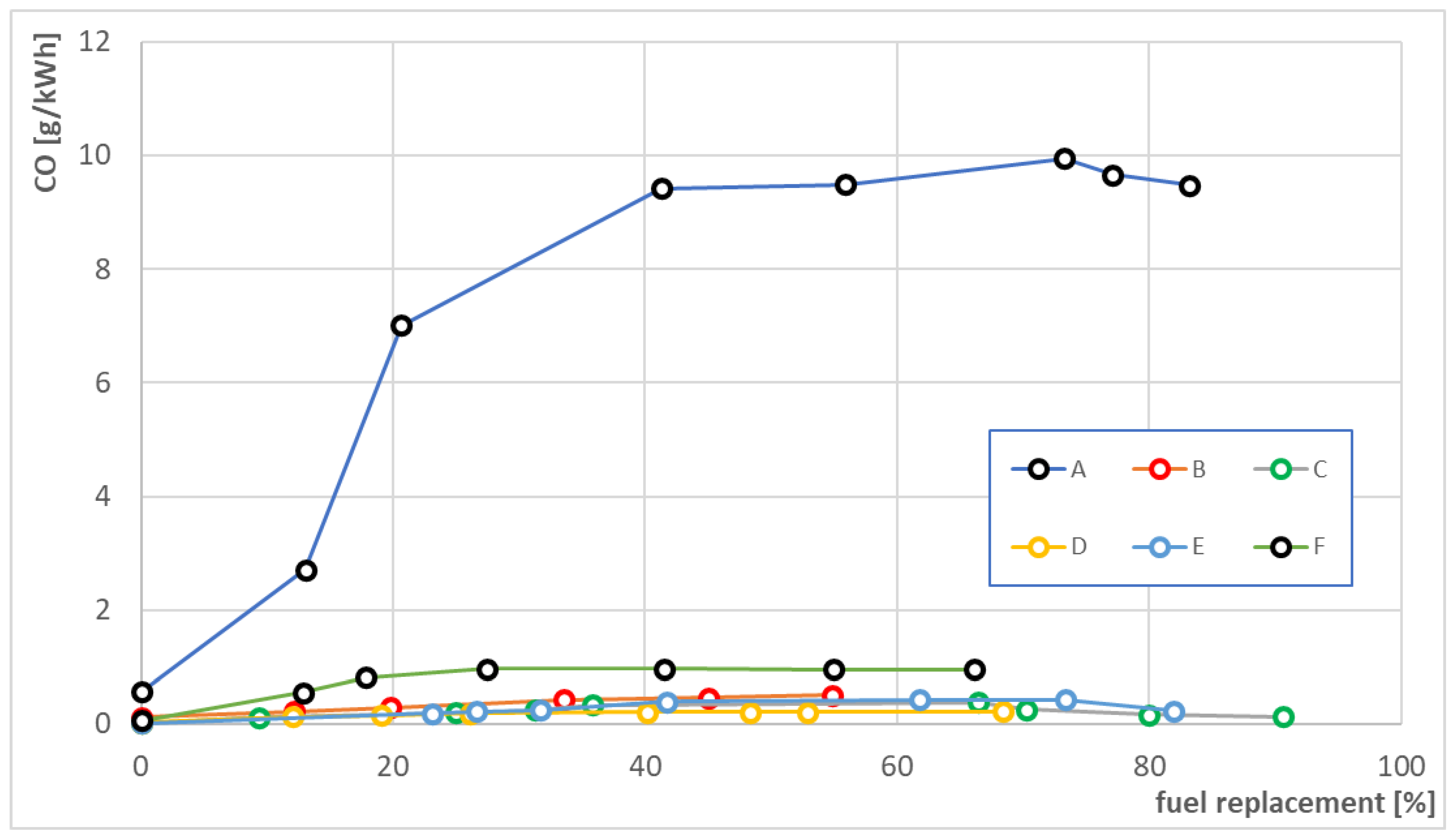








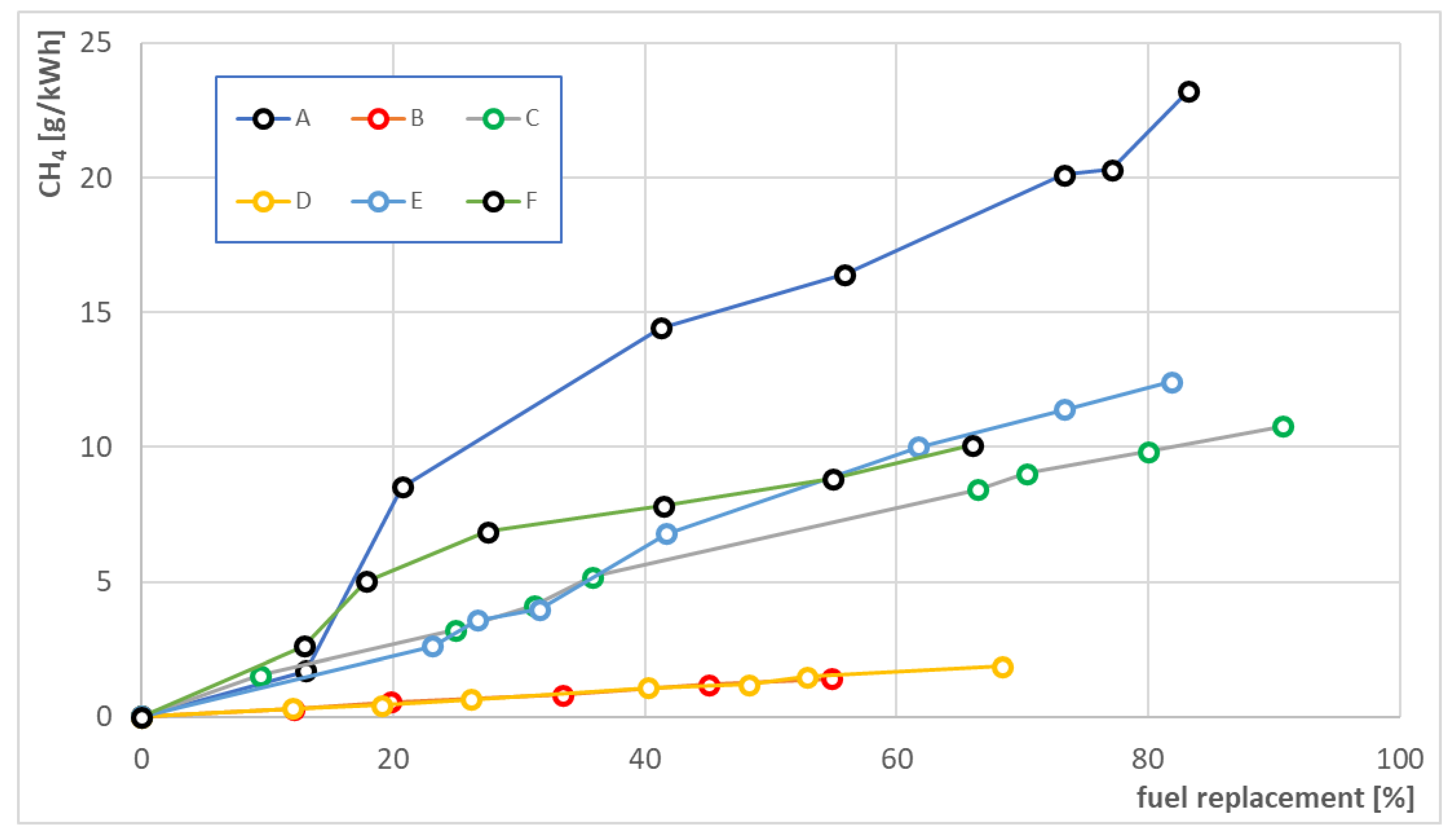
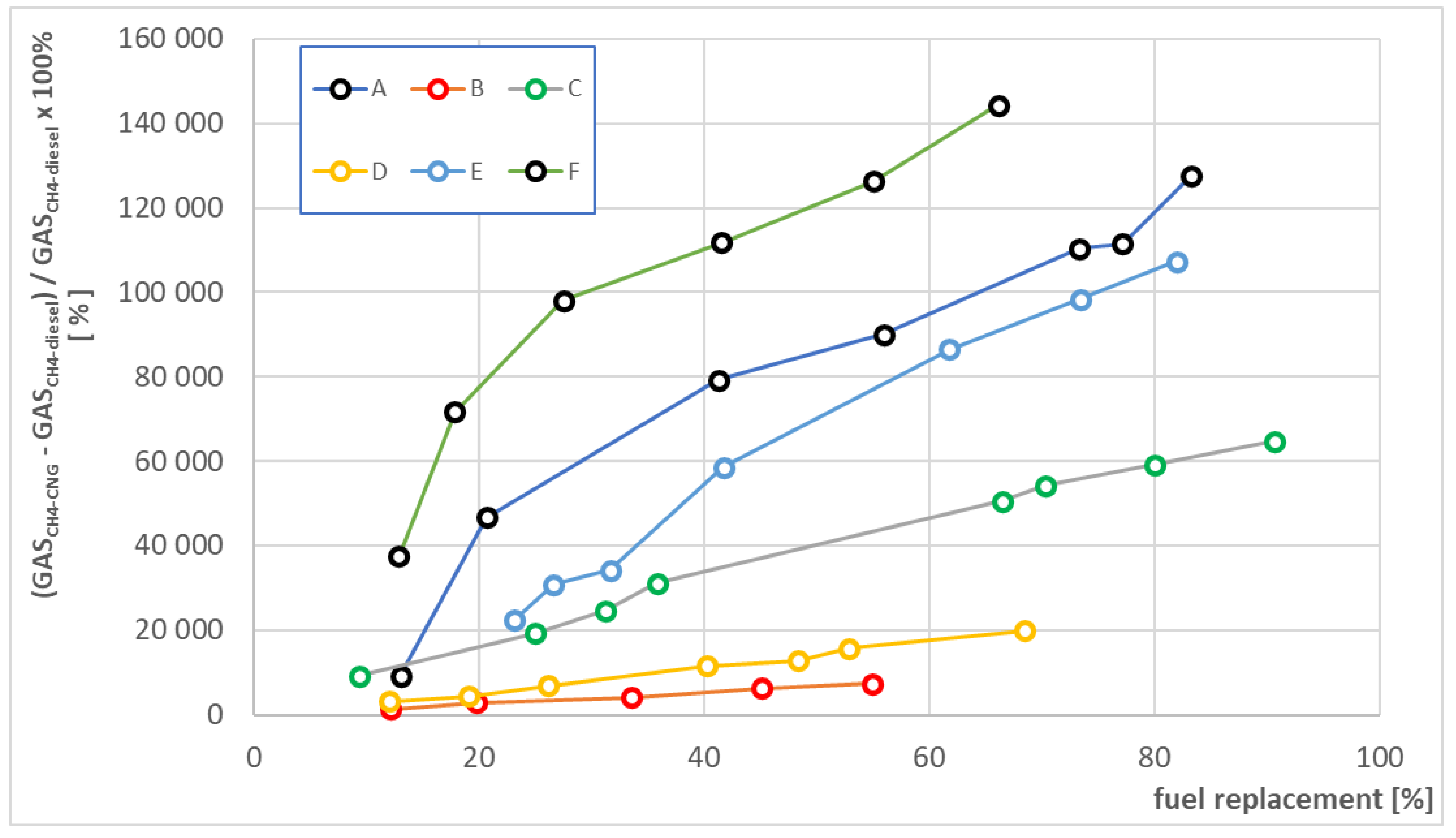
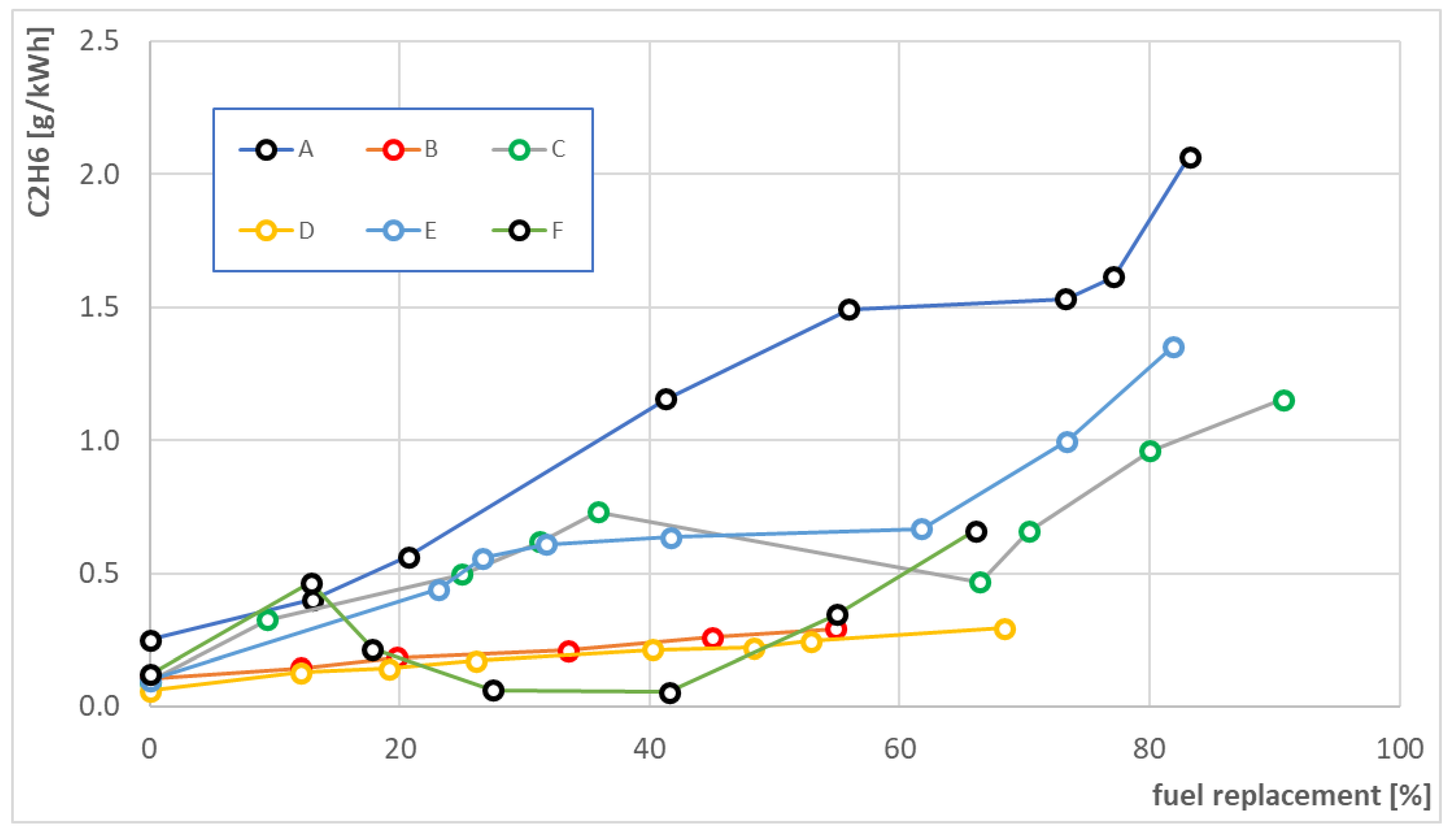
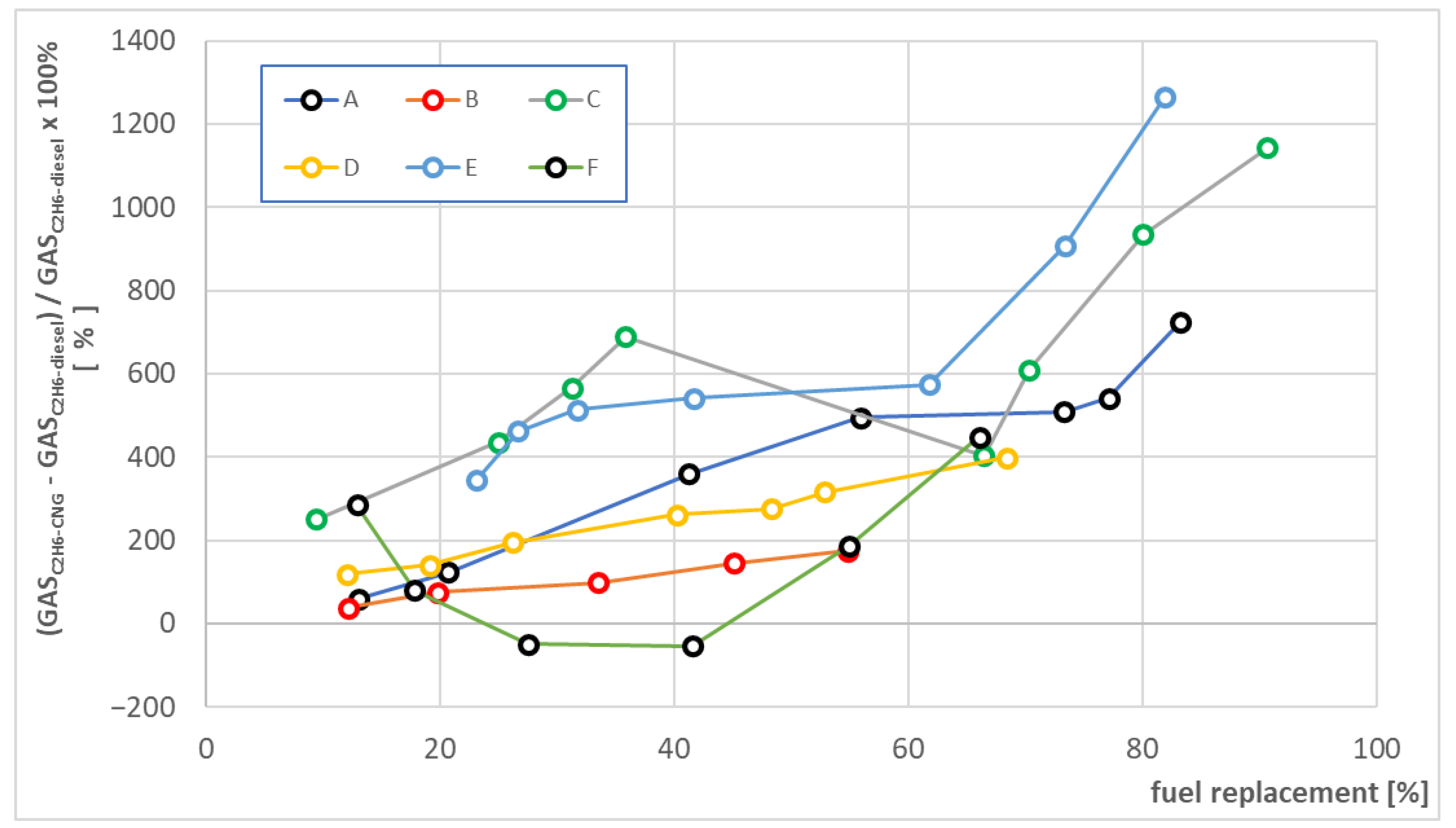


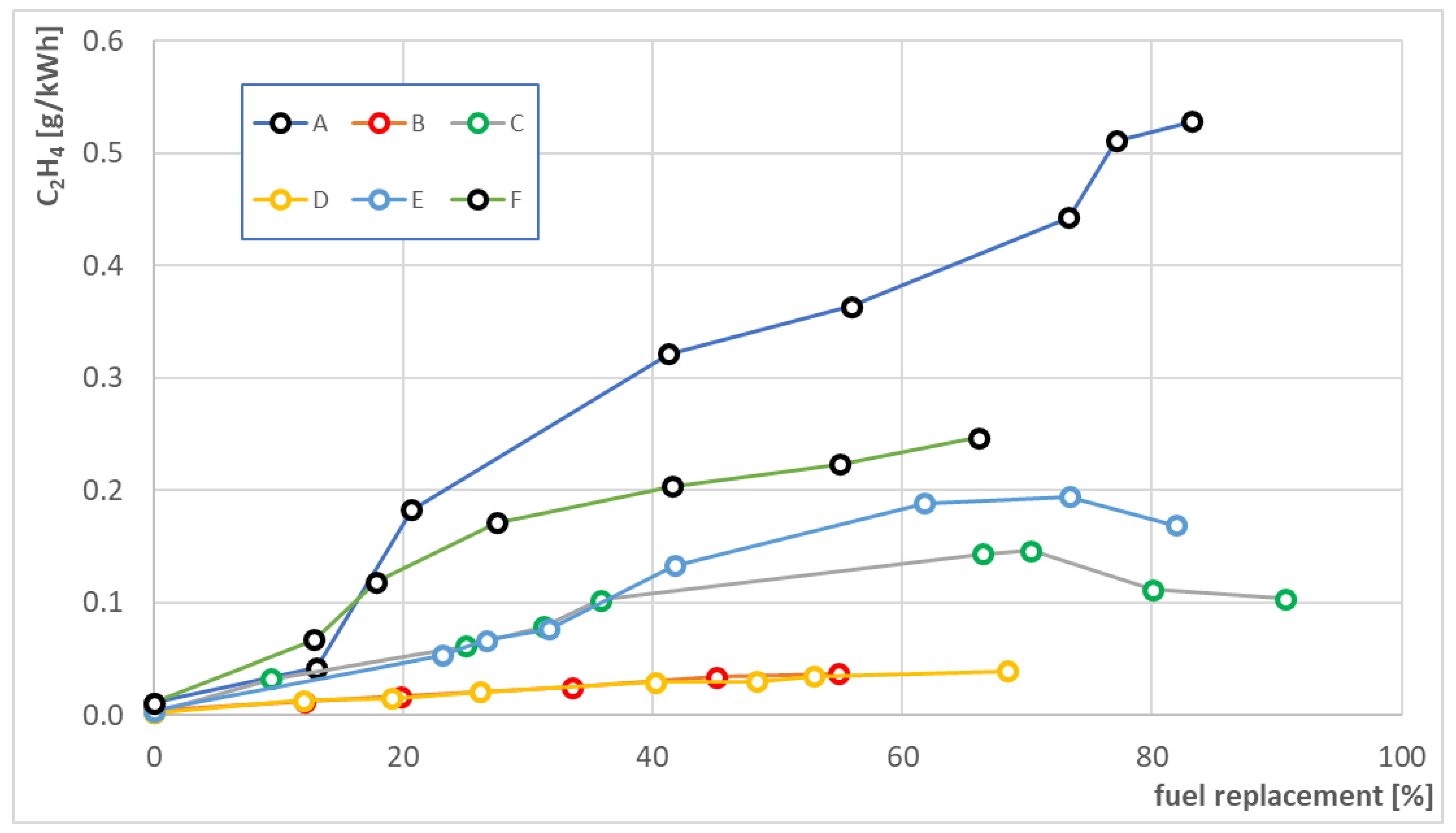






| Euro Scenarios | NOX [mg/kWh] | SPN10 [-] | CO [mg/kWh] | CH4 [mg/kWh] | N2O [mg/kWh] | NH3 [mg/kWh] | THC | NMHC [mg/kWh] |
|---|---|---|---|---|---|---|---|---|
| Euro 5 [27] | 180 | - | 500 | - | - | - | 230-NOX | 230-NOX |
| Euro 6 [28] | 80 | 6 × 1011 | 500 | - | - | - | 170-NOX | 170-NOX |
| Euro 7 A [29] | 30 | 1011 | 300 | 10 | 10 | 5 | 55 | 50 |
| Euro 7 B [29] | 10 | 6 × 1010 | 100 | 5 | 5 | 2 | 30 | 25 |
| Euro V [27] | 2000 | - | 4000 | 1100 | - | - | 1650 | 550 |
| Euro VI [28] | 460 | 6 × 1011 | 4000 | 500 | - | ~40 | 660 | 160 |
| Euro VII A [29] | 120 | 4 × 1011 | 1500 | 100 | 50 | 20 | 150 | 50 |
| Euro VII B [29] | 40 | 1011 | 400 | 50 | 25 | 10 | 75 | 25 |
| Abbreviation | Engine Torque | ENGINE Speed | Lines on Charts | ||
|---|---|---|---|---|---|
| [-] | Assumption | [kNm] | Assumption | [rpm] | [Colors] |
| A | Low | 0.50 | Low | 1100 |  |
| B | High | 1.15 | Low | 1100 |  |
| C | Low | 0.50 | Medium | 1300 |  |
| D | High | 1.00 | Medium | 1300 |  |
| E | Low | 0.50 | High | 1500 |  |
| F | High | 1.05 | High | 1500 |  |
| Rotational Speed [RPM] | Load [Nm] | CNG Replacement Setting [%] When There Is a Minimum Emission Share of: | |||||||||
|---|---|---|---|---|---|---|---|---|---|---|---|
| CO | NO | NO2 | NOX | NH3 | CH4 | C2H6 | NMOC | C2H4 | CH2O | ||
| 1100 | 520 | ON | 83.22 | ON | 77.12 | 77.12 | ON | ON | ON | ON | ON |
| 1150 | ON | 45.05 | ON | 12.1 | 54.86 | ON | ON | ON | ON | ON | |
| 1300 | 480 | ON | 90.68 | ON | 90.68 | 66.44 | ON | ON | ON | ON | ON |
| 980 | ON | 40.2 | ON | 40.20 | 68.38 | ON | ON | ON | ON | ON | |
| 1500 | 500 | ON | 81.91 | ON | 81.91 | 73.37 | ON | ON | ON | ON | ON |
| 1040 | ON | 17.84 | ON | 27.49 | 66.08 | ON | 41.52 | ON | ON | ON | |
Disclaimer/Publisher’s Note: The statements, opinions and data contained in all publications are solely those of the individual author(s) and contributor(s) and not of MDPI and/or the editor(s). MDPI and/or the editor(s) disclaim responsibility for any injury to people or property resulting from any ideas, methods, instructions or products referred to in the content. |
© 2023 by the authors. Licensee MDPI, Basel, Switzerland. This article is an open access article distributed under the terms and conditions of the Creative Commons Attribution (CC BY) license (https://creativecommons.org/licenses/by/4.0/).
Share and Cite
Karczewski, M.; Szamrej, G. Experimental Evaluation of the Effect of Replacing Diesel Fuel by CNG on the Emission of Harmful Exhaust Gas Components and Emission Changes in a Dual-Fuel Engine. Energies 2023, 16, 475. https://doi.org/10.3390/en16010475
Karczewski M, Szamrej G. Experimental Evaluation of the Effect of Replacing Diesel Fuel by CNG on the Emission of Harmful Exhaust Gas Components and Emission Changes in a Dual-Fuel Engine. Energies. 2023; 16(1):475. https://doi.org/10.3390/en16010475
Chicago/Turabian StyleKarczewski, Mirosław, and Grzegorz Szamrej. 2023. "Experimental Evaluation of the Effect of Replacing Diesel Fuel by CNG on the Emission of Harmful Exhaust Gas Components and Emission Changes in a Dual-Fuel Engine" Energies 16, no. 1: 475. https://doi.org/10.3390/en16010475






